BIRTH AND REBIRTH OF THE OMAHA
Thomas P. Myers
University of Nebraska State Museum
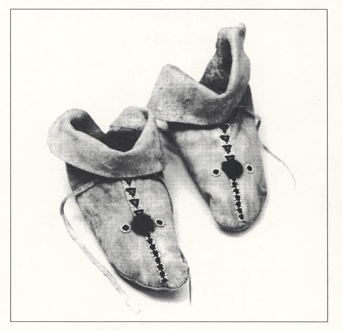
University of Nebraska State Museum
Lincoln, Nebraska
1992
This catalog was prepared to accompany an exhibit entitled "Birth and Rebirth of the Omaha" presented by the University of Nebraska State Museum in cooperation with the Omaha Tribe of Nebraska.
This catalog and the exhibit were partially funded by a grant from the Nebraska Humanitites Council.
REGENTS- Robert M. Allen, Hastings
- Don S. Blank, McCook
- Nancy Hoch, Nebraska City
- Nancy O'Brien, Waterloo
- John W. Payne, Kearney
- Margaret Robinson, Norfolk
- Rosemary Skrupa, Omaha
- Charles W. Wilson, Lincoln
- Graham Spanier
- William Splinter
- Hugh H. Genoways
c. 1991. Regents of the University of Nebraska
Author's Preface
The two great works on the Omaha were written nearly three-quarters of a century ago. They were based upon information provided by men and women who had participated on the last buffalo hunts of their tribe, many of whom had been born before their reservation was restricted to the lands around Macy. The information gathered by J. Owen Dorsey, Alice Fletcher and Francis LaFlesche, himself an Omaha, can never be duplicated. Their works will remain one of our basic sources of information about the Omaha. Those volumes can be studied and re-studied from various points of view to gain new insights about traditional Omaha culture.
There are now many additional sources of information about the historical Omaha which were not available seventy-five years ago. Archaeological evidence from historic and prehistoric sites provides information about the ancestry, relationships and characteristics of the Omaha and their neighbors. The records of the American Fur Company and the correspondence of Spanish governors of Louisiana also provide a great deal of information about the Indians and traders who were active in the area.
Much can also be learned from the Omaha themselves though their culture has changed in the intervening decades. Dorsey, Fletcher and LaFlesche believed that Omaha culture was dying. The elders with whom they spoke also believed it. Many of them wanted to record what they remembered so that it would not be forgotten. They would be pleased to discover that many Omaha again want to learn their own history and the traditions of their people. We are wittnessing the revival of Omaha culture not as a relic of the past but as the heritage of the present.
I am indebted to Doran Morris, Chairman of the Omaha Tribe of Nebraska, and Dennis Hastings, Director of the Omaha Historical Project for their help and advice in the preparation of this work. During the preparation of exhibit copy for "Birth and Rebirth of the Omaha," discussions with Judy Diamond and Patty Amgwert helped to sharpen my thinking and forced me to re-examine certain concepts. Debbie Meier, Exhibits Preparator, executed the line drawings when they desparately needed to be done. John Green photographed the artifacts which illustrate this catalog. I appreciate the help of my wife, Joan A. Myers, who read and commented upon the manuscript in its penultimate stage.
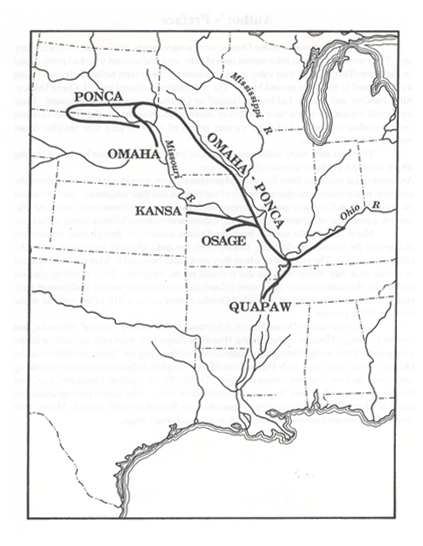
Fig 1. Map of the migrations of the five cognate tribes.
Introduction
Living societies are constantly changing though some change more rapidly than others. Omaha society is no exception. Oral tradition emphasizes the fact that Omaha society was created by tribal elders and leaders who realized that the old ways were no longer keeping the people together. They met in council to reorganize the tribe. Their decisions were endorsed by a gift from Wakon'da, the Sacred Pole which would keep the people together. By 1888, conditions had changed again. The Sacred Pole was no longer able to hold the people together. It left the tribe to be preserved in the Peabody Museum of Harvard University for more than a century. By the 1980s, the people were coming together again. The Tribal Council arranged for the Sacred Pole to be returned to the people. This great event took place at the Omaha Powwow in 1989. The Sacred Pole brings the people together again.
Omaha Origins
The language of the Omaha is so similar to the languages of the Quapaw, Osage, Kansa and Ponca tribes that each can understand the other. According to their oral traditions, hundreds of years ago the ancestors of these cognate tribes lived together along the Ohio River, above the mouth of the Wabash, in Indiana and Kentucky. Sometime between A.D. 1400 and 1700 they began to move westward toward the Mississippi River (fig. 1). Upon reaching the Mississippi, the Quapaw, known as the downstream people, moved southward to the Arkansas River, arriving some-time between 1541 and 1673. The others turned northward, the Omaha going against the current. The Osage and Kansa traveled up the Missouri River, reaching their present homelands before 1700. Meanwhile the Omaha, known as the up-stream people, and the Ponca continued northward up the Des Moines River, reaching northern Iowa by 1697. There they associated with the loway tribe native to the region.
If we accept the oral tradition that the ancestors of the Omaha and their relatives lived in the Ohio Valley during the late prehistoric period, they must have been associated with the Angel and Caborn-Welborn Phases which dominated the region from about A.D. 900 until early historic times. The Angel site (fig. 2) was an important fortified town of the Mississippian Tradition with three platform mounds, a village plaza and a population of about 1000 people. Many other towns in the vicinity lacked mounds but all participated in a stratified society in which specialized goods were produced for an elite class. Indian corn and deer were the principal foods. Shortly before A.D. 1600 climatic changes resulted in an eastward expansion of the prairie which brought bison into this part of the Ohio valley for the first time.
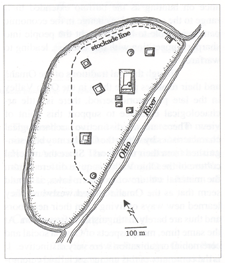
Fig 2. Plan of Angel site on the Ohio River in southern Indiana.
Omaha oral traditions speak of bark houses, possibly referring to the rectangular bark houses occupied by peoples of the Angel Complex. Similar bark houses were occupied in north-ern Iowa. Earth lodge dwellings of the recent past were not adopted until the Omaha moved to the Missouri River where they learned to make them from the Arikara tribe. Tipis may be an even later addition to the culture.
We do not know what caused the Omaha and their relatives to abandon the Ohio Valley. The region was sparsely populated when whites entered in the late 1600s. Factors contributing to the abandonment may have included a changing environment as the prairies moved eastward; war-fare among the Oneota peoples on the Illinois prairies; and/or European diseases brought by the DeSoto expedition in the early 1540s. The east-ward expansion of the prairie reflects a change in the rainfall pattern making it more difficult for farmers to raise corn and favoring a greater reliance on hunting as the buffalo extended their range to the east. Such a change in the economic pattern is liable to have brought the people into sharper competition with one another, leading to warfare.
Though the oral traditions of the Omaha and their relatives place them in the Ohio Valley in the late prehistoric period, there is little archaeological evidence to support this point of view. There are no distinctive archaeological characteristics by which the Omaha may be distinguished from their neighbors. Since the material culture of the Ohio Valley is quite different from the material culture of northern Iowa, it would seem that as the Omaha moved westward, they learned new ways of living from their neighbors and thus are barely distinguishable from them. At the same time, many aspects of Omaha social and ceremonial organization were very distinctive. It is the continuity of this unique social and ceremonial organization which makes the people Omaha, rather than the artifacts used for cooking or hunting which are preserved in archaeological sites.
Social Organization
In addition to a common language, features of social and ceremonial organization which the Omaha share with their closest relatives suggest what the society might have been like before their migration westward and their breakup into distinct tribes.
Until very recently, the clan organization was one of the fundamental realities of Omaha life. It governed tribal responsibilities and marriage relationships. The interdependence of the tribe was reflected by the responsibilities allotted to each of the clans, none of which could perform the essential ceremonies by itself. In performing the ceremonies associated the the Sacred Pole, the Waxthe'xeton subclan of the Hon'ga clan responsible for the ceremonies could only perform them in the presence of the Xu'ka subclan of the Tha'tada clan who had the responsibility of acting as prompters. In the past, boys wore a haircut distinctive of their clan. This practice is shared only with the Ioway, the Omaha's neighbors in northern Iowa, and not with the cognate tribes.
A person must marry someone of another clan. By this standard, many of the younger Omaha are now in relationships that would have been impossible if the obligations of the clan structure had not been forgotten. Some elders believe that these irregular relationships continue to the detriment of the tribe. The same elders add that it is not the fault of the young people but of the elders themselves who failed to teach the proper behavior to the young people.
Each clan had its place around the village circle while the Omaha were on the buffalo hunt (Fig. 3). This circular pattern, but not the details, of clan placement is shared by the cognate tribes. The principal axis of the Omaha tribal circle is
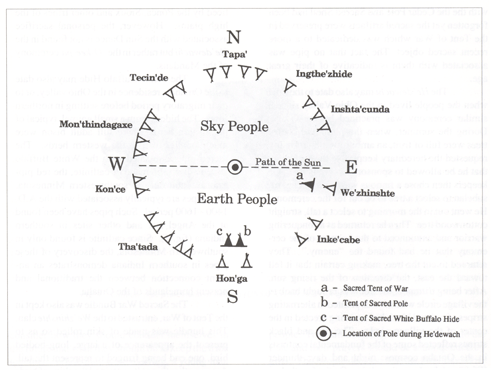
Fig 3. Sacred camp circle of the Omaha during the he'dewachi..
east-west, along the path of the sun. The tribe is divided into northern and southern divisions, sky people and earth people. Other features of Omaha life are associated with this bipartite division which is part of the balance of the universe: The numbers four and seven also recur in many sacred contexts of the Omaha and other tribes of North America. The primary references are to the four winds, encompassing the whole earth, and the whole universe with the addition of above, below and right here.
| sky | earth |
| north | south |
| sun | moon |
| male | female |
| above | below |
| father | mother |
| day | night |
| right | left |
Ceremonial Organization
The Sacred Shell and the Cedar Pole upon which it hung may be associated with the most ancient rites of the Omaha. Together they represented the male and female principles, and thus the balance of the universe which appears in many guises. By the 1870s, the rites associated
with the the Cedar Pole and Sacred Shell had been forgotten yet the sacred artifacts were preserved in the Tent of War which was dedicated to a more recent sacred object. The fact that no pipe was associated with them is indicative of their great age.
The He'dewachi may also date to the time when the people lived in the Ohio Valley since a similar ceremony was practiced by the Osage. During the summer, when the plum and cherry trees were full of fruit, an ambitious man formally requested the hereditary keepers of the ceremony that he be allowed to sponsor the ceremony. The keepers then chose a famous warrior of their own subclan to select a tree to be cut for the ceremony. He went out in the morning to select a tall, straight cottonwood tree. Then he returned as a conquering warrior and announced to the keepers of the ceremony that he had found the "enemy." They returned to cut the tree, making certain that it fell toward the east, the direction of the rising sun. After being trimmed, the tree was brought back to the village circle where it was painted in alternating stripes of red and black before being erected in the center of the village circle. The red and black stripes reflected some of the fundamental contrasts in the Omaha cosmos: night and day; thunder [life?] and death; earth and sky. On the fourth day, the people formed in two circles around the village: men in front; women in the rear. Then they approached the pole and danced around it: men with their right shoulder to the pole, clockwise; women with their left shoulder to the pole, counter-clockwise.
The sacred circle with a central pole is a widespread cosmological concept found on all the inhabited continents. It is represented at the great Mississippian center at Cahokia, near St. Louis, to which the Angel site in the Omaha homeland was subordinate. The Omaha sacred circle (fig.3) con-forms to the general pattern with the most sacred point at the center of the circle the least sacred part at the perimeter marked by the tipis. Chaos lies beyond. The sacred circle symbolism of the He'dewachi is found also in the Sun Dance practiced by the Ponca, Sioux and other tribes of the high plains. However, the personal sacrifice associated with the Sun Dance is not found in the He'dewachi but rather in the O-kee-pa ceremony of the Mandans.
The White Buffalo Hide may also date to the Omaha's residence in the Ohio valley, or to their migratory period before settling in northern Iowa. The hide is from a small animal, typical of the eastern herds where full adult bison were much smaller than in the western herds. The sacred pipe associated with the White Buffalo Hide is disc pipe made of catlinite, the red pipestone found only in southwestern Minnesota. Disc pipes are typically associated with the A.D. 1400 - 1600 period. Such pipes have been found at the Angel site and other sites in southern Indiana (fig. 4). Since catlinite is found only in southwestern Minnesota, the discovery of these pipes in southern Indiana demonstrates an ancient connection between the traditional and present homelands of the Omaha.
The Sacred War Bundle was also kept in the Tent of War, entrusted to the We'zhinshte clan. This bundle was made of skin rolled so as to present the appearance of a large, long-bodied bird, one end being fringed to represent the tail. Among other things it contained the skins of birds which were supposed to be omniscient and were the representatives of Thunder along with two pipes associated with the bundle. Though the pack could give authority to offensive warfare, the pipes were smoked only to authorize defensive warfare. The catlinite pipes in the pack are of a later style than the White Buffalo pipe, probably dating to after A.D. 1600 but before the reorganization of the tribe.
Birth of the Omaha
Following the Des Moines River northward into northern Iowa and southern Minnesota, tribal elders and leaders began to realize that their world had changed. They met in council to
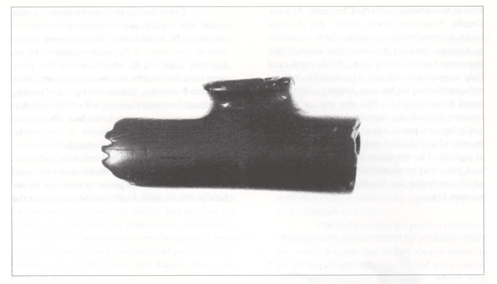
Fig 4. Catlinite pipe from southern Indiana (UNSM A91.16.10). gift of Tom and Delta Cain.
consider how they should conduct themselves in the future and what they should do to keep the tribe together. While they were meeting, a young man lost his way in the forest. At last he saw a light which he approached thinking it might be a tent. Instead, he found a tree which set forth light yet was not consumed by it. After watching the tree for two nights, the young man returned home where he told his father about his discovery. They returned to the tree which again glowed in the darkness. The father found something that his son had not observed: four animal paths led up the the tree where the animals rubbed against the tree, polishing its bark. Father and son returned to the people where they told the elders what they had found. It was agreed that the tree was a gift from Wakon'da and that it would he the thing that would keep the people together. The tree was attacked as an enemy, just as the tree in the He'dewachi ceremony, then brought back to camp where it was dressed as a man. The chiefs said that the Pole belonged to the people. They should bring all their troubles to the Pole and their prayers should be accompanied by gifts. The people decided that the Pole should be honored in the Moon when the Buffaloes Bellow [July] and that the ceremony should he kept up.
The Pole, being found as the elders and leaders were deliberating the reorganization of the tribe, provided a supernatural sanction of the action being taken by the council. It was this council which organized the Tribe into its historic form, making use of many elements which were already in the culture: the clan system; the sacred circle and the position of the clans around it; the bipartite division; the sacred numbers four and seven; and the White Buffalo hide. The new Sacred Pole seems to have eclipsed the Cedar Pole and the Sacred Shell which may have been the key elements in the previous organization of the tribe.
According to some versions of the legend of the Sacred Pole, the council being held at the time of its discovery was an intertribal council
with representatives from the Cheyenne, Arikara, Omaha, Ponca and loway tribes. For the time being, it seems better to consider the two councils as separate because the intertribal council had important business of its own. While the Sacred Pole is associated with war, this council is credited with establishing the Wa'wan, a rite by which peace could be established. This rite was conducted between individuals, supported by their kinsmen and tribesmen, just as war was usually undertaken by individual initiative and supported by the tribe as a whole. The site where this intertribal council took place may be identified as the Blood Run site which overlooks the Big Sioux River in north-western Iowa.
To initiate the Wa'wan ceremony, a man of one tribe would ask permission of the chiefs of another tribe to undertake the ceremony with a man of that tribe. If that man, supported by his kinsmen, accepted the invitation, the first party went to the lodge of the honoree and presented him with the Friendship Calumets (fig. 5). Feasting continued for two or three days. On the fourth day, the visitors gave presents to the host who passed them the chiefs for distribution to the people. Often the pile of gifts was as much as four feet high. Then, gifts from the hosts were presented to the visitors. Afterwards the two calumets used in the ceremony were given to someone in the family, often a child. Unlike the Sacred Pole or the
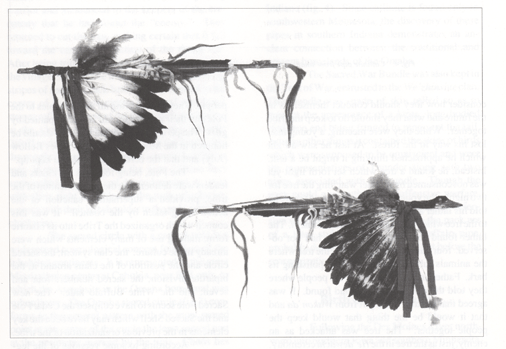
Fig 5. Peace wands used in the friendship ceremonies. Property of the Omaha Tribe.
White Buffalo Hide, the pipes of the Calumet Ceremony are not sacred and are not specially charged to the care of a clan or an individual. They are made anew for each ceremony.
Though referred to as "pipes" or "calumets," the pipes associated with the Wa'wan are not pipes which can be smoked. Nor is the calumet ceremony of the Omaha and other prairie tribes the same as the calumet ceremony of eastern North America.
After leaving the Blood Run site before 1720, the Omaha moved to the Missouri River near Lake Andes in South Dakota. Subsequently they moved southward toward the fur traders who were ascending the Missouri River from St. Louis which was founded in 1764. Fur traders had reached the Pawnee by 1769 and the Ponca were contacted in 1779. In 1775 two traders were licensed to trade with the Omaha who exported 5000 pounds of fur, second only to the Osage and Kansa among the tribes of the Missouri River.
Old World epidemic diseases were introduced to the American Indians shortly after Columbus' rediscovery of the Americas. Often these diseases spread far in advance of white exploration. Perhaps the most devastating period of disease was the smallpox epidemic of 1520 - 1524 introduced to North America during DeSoto's exporation of the southeast. Measles, bubonic plague, diptheria, whooping cough and influenza were other major killers of the Native Americans who had no natural resistance to these imported diseases. The most recent epidemics to affect the Omaha include the smallpox epidemics of 1778-83, 1800-03, 1831-34 and 1836-40. In populations not previously affected i.e., virgin soil populations, the mortality rate may approach 90% but subsequent occurrences would be much less devastating. Populations rebuild rapidly after epidemics, often at the rate of more than 1 % per year. Many of the people with vital traditional knowledge died without the opportunity to convey their learning to a successor. Thus, it is virtually certain that not only did many Omaha die during the epidemics, much of their esoteric knowledge was lost as well.
Fur Trade
It is uncertain when the people who were to become the Omaha first met the whites. Omaha oral tradition tells of a time when the people were living in the north where there were birch trees, the people discovered "white objects" on the waters [of a great lake] which floated toward the shores. Men got out of them." Though Lake Winnipeg has been suggested as the site of this event, it is more likely to have taken place on Lake Michigan where LaSalle's "Griffin" visited Green Bay in 1679. Regular trade with the Missouri River tribes did not begin until after European title to the region had passed to the Spanish in 1765.
The Indians were not passive receptors of cheap trade goods offered by predatory traders. While it is true that traders always strove to get the advantage, both Indians and whites were active participants in the system which was competitive because of the many tribes offering skins and because of intense competition among the traders. Although Spanish traders were supposed hold a monopoly until the end of Spanish rule, they were regularly challenged by illegal English or American traders from east of the Mississippi. Under American administration, competition was still the order of the day no matter how hard the American Fur Company and its allies tried to drive out their challengers.
Spanish trade goods included various kinds of cloth, ribbons, vermilion, blankets, axes, pipe tomahawks, hoes, knives, beads, English rifles and powder but there is no mention of cooking pots or silver ornaments aside from medals presented to chiefs. These ornaments, many of them manufactured in Montreal (fig. 6), were introduced by English or American traders. Rifles and powder were surprisingly important trade goods as early as the 1790s. Zenon Trudeau. Spanish Governor at St. Louis, reported that although the Osage still used bows and arrows in war, they were so accustomed to Spanish arms and munitions for hunting, that they could not
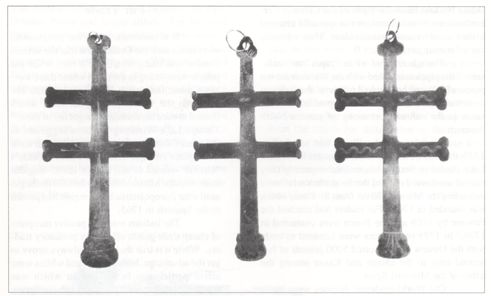
Fig 6. Silver crosses made in Montreal and traded to Indian tribes of the western Great Lakes and Missouri River by French, then English traders. Property of the Omaha Tribe.
exist without Spanish trade. Being farther from the source of supply, guns may have been less important to the Omaha.
English or American traders from east of the Mississippi offered an alternative source of supply at lower prices than offered by the Spaniards. One of these illegal traders was captured in 1773 after spending several months trading with the Missouri and Little Osage. The inventory of his canoes provides the best available evidence of trade goods on the Missouri in the late 1700s. He carried quantities 2 1/2, 3 and 4 point blankets, cloth, copper kettles, glass beads, bone, silver and copper ornaments, wool, scissors, knives, hoes, vermilion, needles, awls, chisels, gunpowder and guns still unexpended during his trade with the Indians, He also carried large quantities of grease and tallow, bags of beaver tails and deer tongues as well as deer, bear, fox, cat and beaver hides and a few buffalo hides without the hair which he had obtained in trade.
We would know little about Omaha participation in the fur trade were itnot for the excavation of burials in Omaha cemeteries near Tonwontonga, the Big Village of the Omaha, which was occupied on several occasions during the Spanish and American fur trade periods, until about 1840. The quantity of trade goods with the burials demonstrates that the Omaha were successful participants in the fur trade. Among the trade goods found in the cemetery are quantities of gun parts suggesting that the man with whom they were buried was a gunsmith for his tribe. There were also many, many trade beads including both glass beads and shell wampum, copper cookware, silver, brass and copper ornaments, scissors, axes, spear points and even clay pipes (figs. 6-9). Tiny fragments of cloth preserved
next to copper buttons demonstrate that the Omaha were also trading for cloth goods in the traders' inventories.
One of the most startling discoveries in the Omaha cemetery was evidence of a wampum belt. Wampum (tubular shell beads) was indigenous to the tribes of the eastern seaboard where it served as a native money. Whites soon learned to manufacture wampum, making it more easily available while retaining much of its traditional value. Its use spread to the Iroquois of upstate New York and then to the peoples of the Great Lakes. Typically wampum belts were employed to confirm important relationships among the tribes including a call to war against common enemies. French, English, Americans and Spanish were quick to pick up on this indigenous system. In 1773, Pedro Piernas the Spanish governor in St. Louis sent soldiers up the river with wampum belts to enlist the aid of the chiefs against the American interlopers. British and Americans were circulating the bloody belts of war and the white belts of peace among the Illinois tribes in 1778. In 1794, a chief of the Pawnee Loups referred to a wampum belt he had been sent to go to war against the Osage. Wampum belts were still in use as late as 1837 when the Sac and Fox sent wampum belts to the Winnebago, Iowa, Oto, Pawnee and Omaha to enlist their aid against the Sioux.
By 1830, Sioux and Ponca aggression was becoming sufficiently intense that the Omaha were forced to leave their village on the Missouri River near Homer, Nebraska in favaor of a safer location on the Elkhorn River. In 1836 they re-moved to the vicinity of Bellevue, Nebraska to be near the government agency where the government promised to fence and break 100 acres for the use of the tribe. Meanwhile, increasing numbers of whites were crossing Omaha hunting grounds on the Oregon or California trails. Others were settling in southeastern Nebraska. In the Treaty of 1854 the Omaha ceded their lands west of the Missouri river and south of a line where the Iowa River leaves the bluffs. Following this treaty, the Omaha moved to their present location in northeastern Nebraska.
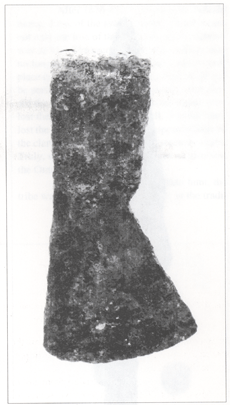
Fig 7. Iron axe of the type traded by Americans. Property of the Omaha Tribe.
Bellevue, Falls City, Nebraska City and many other towns in southeastern Nebraska were founded during the middle 1850s.
Reservation
As the American frontier expanded westward across the Alleganies into the upper Ohio Valley and Great Lakes, many Indian tribes continued their westward retreats which had begun with the Iroquois raids on Michigan, Wisconsin and Illinois in the 1670s and 1680s. In 1830, the
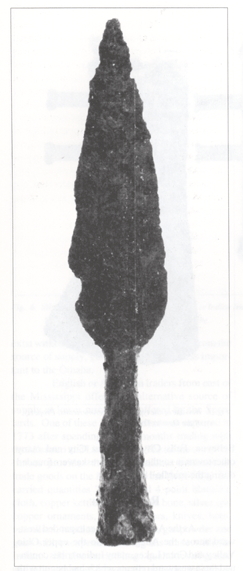
Fig 8. Iron spear point traded to the Omaha in the early 1800's
Omaha relinquished their claims to lands in the present state of Iowa at the Treaty of Prairie du Chien and in 1836 gave up the lands between Missouri border and the Missouri Rivers. In 1854, they were restricted to a reservation in northeastern Nebraska which was reduced to its present size in 1865.
Even after the Omaha had been confined to a reservation they continued the annual buffalo hunts. The summer hunt was important not only because it provided the food upon which the people were to live, but also because summer was sacred season, the only time when the tribal circle was formed. During the winter, long before the hunt was to take place, a man prepared himself to become director of the hunt. With the help of his family, he gathered the materials necessary to make the wsha'be, the staff of office. These consisted of an ash sapling, a black and a golden eagle, a crow, a swan, a dressed buffalo skin, two pieces of sinew, a shell disk, a copper kettle and a pipestem. As the time of the hunt grew near, he took these things to the leader of the Washa'be subclan of the Hon'go clan to which belonged the hereditary right to make the staff. Then the Washa'beto subclan of the Hon'go clan called a council composed of the governing tribal council, the Washa'be subclan and the man who was to lead the hunt. This council determined the direction of the hunt and the day of departure but other details were left up to the director of the hunt.
Finally the great day came. There was no organized plan of departure. Those ready to leave left first. Others would catch up, perhaps the next day. The director of the hunt would leave last, walking barefoot and carrying no weapons. His self-sacrifice was a prayer to Wakon'da. The tribe traveled westward for three or four days before reaching buffalo country. Then the council met again to appoint "soldiers" who would enforce order as the tribe approached the herd. There must be no barking dogs, no loud calls or other noise that might disturb the animals. No one might sneak away early to hunt before the whole tribe was ready to participate. Once the herd was
surrounded, the soldiers held the people back until the signal was given to attack. Any precipitate actions might stampede the herd to the detriment of the people. Then runners were chosen to find the herd and report back to camp where they were met by the Sacred Pole and White Buffalo Hide. The herd was approached in a sacred manner in four stages, then the herd was surrounded by the hunters led by two youths who carried the crooked lance and the pipestem. Finally the signal to attack was given. Hunters rode into the confused and frightened herd, driving it toward the camp and killing the animals as best they could. Boys dove into the herd to collect twenty tongues and a heart for the sacred feast which would follow the hunt.
After 1876 there were no more buffalo hunts. Loss of the annual summer hunt meant not only the loss of the meat but also a changed way of life. The sacred circle of the village was no longer formed. The ceremonies which took place during the summer buffalo hunt could not be performed in their proper context. Not only did the Omaha loose their economic base, they lost their ceremonial life as well. Further, they lost the context of most of the responsibilities of the clans and the interactions between the clans. Truly, when the buffalo were gone so also was the Omaha way of life.
Even before the last buffalo hunt, the tribe was no longer living together in the tradi-
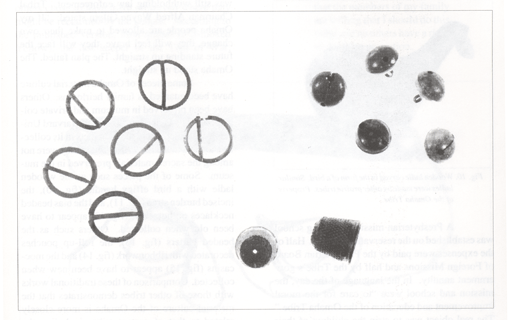
Brooches, belts and trade goods probably brought to American traders. Property of the Omaha Tribe.
tional manner on the reservation. Instead, three villages had emerged. The northernmost village was the village of Two Crows. The middle village was an earth lodge village on Blackbird Creek near the Agency. The southernmost village was the village of the "wood eaters" who cut and sold wood to steamboats on the Missouri and to white settlers who lived near them. A fourth village, called the village of the "make-believe white men" was established near the mission school under the leadership of Joseph LaFlesche. Here the progressives lived in board houses rather than the traditional earth lodges, and made their living by activities associated with the church and school.
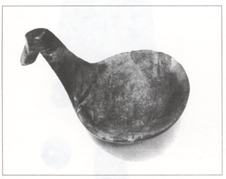
Fig 10. Wooden ladle carved in the form of a bird. Similiar ladles were made by other prairie tribes. Property of the Omaha Tribe.
A Presbyterian mission boarding school was established on the reservation in 1857. Half of the expenses were paid by the Presbyterian Board of Foreign Missions and half by the Tribe's government annuity. In the language of the day, the mission and school were "to care for the moral improvement and education of the Omaha Tribe." The real object was to strip the children of their Omaha heritage and to replace it with Americanisms. The children's hair was cut; they were forced to wear American clothes and to speak English. Even their names were changed into good American names such as George Washington and Andrew Jackson.
In 1882, an act of Congress authorized the division of reservation land individually to each man, woman and child of the tribe. Traditional tribal organization ceased to exist. Many left the village to live on their lands which were scattered about the reservation. Others sold their land at a fraction of its value or rented it to whites. Today, much of the land within the boundaries of the reservation is still owned by whites and a substantial amount of Omaha-owned land is still rented to whites.
The Bureau of Indian Affairs planned to abolish the Omaha agency in 1958, and to turn its services over to state and local government that was still withholding law enforcement. Tribal Chairman Alfred Wayne Gilpin stated: "If my Omaha people are allowed to make their own change, they will feel brave, they will face the future standing up straight. The plan failed. The Omaha stood up straight.
Some pieces of Omaha material culture have been guarded as family heirlooms. Others have been preserved in museum and private collections. The Peabody Museum of Harvard University returned many of the objects in its collection to the Omaha in 1990 although they were not among the sacred materials preserved in the museum. Some of the pieces such as the wooden ladle with a bird effigy handle (fig. 10), the incised burden strap (fig. 11), and the bias beaded necklaces on horsehair (fig. 12) appear to have been old when collected. Others such as the beaded garters (fig. 13), the roll-up pouches decorated with ribbonwork (fig. 14) and the moccasins (fig. 15) appear to have been new when collected. Comparison of these traditional works with those of other tribes demonstrates that the material culture of the Omaha is more closely related to that of eastern tribes including the Iowa, Sac and Fox, and Ojibway than it is to the products of the nomadic tribes of the plains such as the Sioux or Cheyenne.
The Omaha tribal collection is being curated by the University of Nebraska State Museum until the planned cultural center can be established on the reservation. This cultural center will offer exhibits designed to educate tribal members and their neighbors. It will also collect and preserve books, documents, music and photographs which contribute to a better understanding of the Omaha Tribe and its history.
Rebirth of the Omaha
The rebirth of the Omaha began in the 1880s as the elders realized that their traditional way of life was lost forever. While some chose to be buried with the sacred things under their care, others chose to have them preserved where they might be reclaimed by the people. According to the published version, Mon'hinthinge (Smoked Yellow), the last keeper of the Tent of War, entrusted the Sacred Pole of the Omaha to the Peabody Museum in June 1884 with the words:
These sacred articles have been in the keeping of my family for many generations; no one knows how long My sons have chosen a path different from that of their fathers. I had thought to have these articles buried with me; but if you will place them where they will be safe and where my children can look on them when they wish to think of the past and of the way their fathers walk, I give them into your keeping .... I know that the members of my family are willing that I should do this thing and no others have a right to question my action.
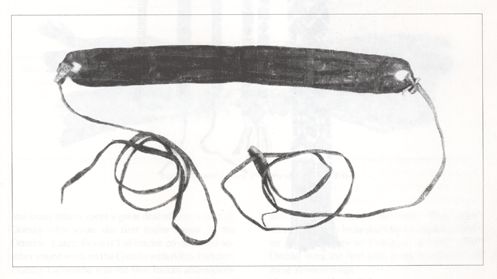
Fig 11. Incised buffalo hide burden strap. Property of the Omaha Tribe.
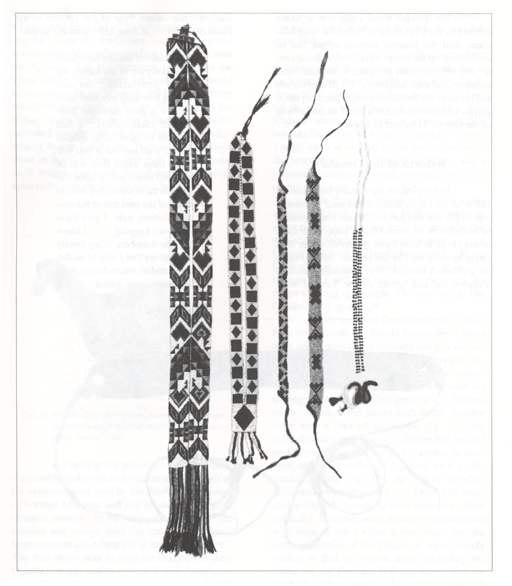
Fig 12. Beaded necklaces. Property of the Omaha Tribe.
Members of the family have a different version of the transfer of the Sacred Pole to Peabody Museum. According to family tradition, Smoked Yellow had talked to Francis LaFlesche and Alice Fletcher about safeguarding the Sacred Pole in the museum but found that the Pole had disappeared before he had made the decision. The Albino Buffalo Hide was certainly stolen. Though Fletcher and LaFlesche had paid its keeper a great deal of money, one day the Hide was missing. It entered a private collection. Then it was transferred to the Chicago Academy of Sciences and again to the Museum of the American Indian, Heye Foundation in New York City which recently became part of the U.S. National Museum. Both the Sacred Pole and the Albino Buffalo Hide have now been returned to the Tribe.
Others preserved their traditions by talking to anthropologists. Two Crows, Joseph LaFlesche
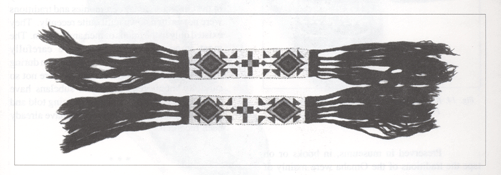
Fig 13. Beaded garters. Property of the Omaha Tribe.
and many others spent a great deal of time with J.O. Dorsey who wrote the first major report on the Omaha. Later, Francis LaFlesche co-authored an-other major work on the Omaha with Alice Fletcher. Francis LaFlesche was the first Indian anthropologist. He helped to preserve not only the traditions of the Omaha but also those of the Osage. Omaha memories of the LaFlesches, father and son, are mixed. They were progressives who foresaw the end of Omaha culture and wanted to become like the whites. At the same time they wanted to see that Omaha traditions and even the sacred objects were preserved. Francis LaFlesche was instrumental in the development of Omaha museum collections. Traditionalists opposed the LaFlesches' efforts. They refused to live in the village of the make-believe white men. They preserved the sacred objects in their own care, transferring them to suitable successors or being buried with them.
The songs of the Omaha were preserved on ninety wax cylinders through the efforts of Francis LaFlesche about 1891. He may have been the first anthropologist to make field recordings of American Indian music. Remark-
ably, these recordings survived. They were transferred onto laser discs by the Folklife Center of the Library of Congress in 1984. The Omaha were the first tribe to receive copies of these re-recordings.
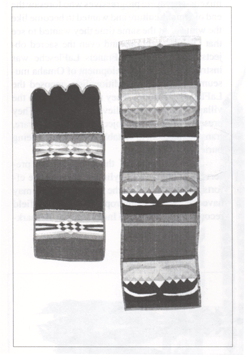
Fig 14. Roll-up pouches with ribbon-work decoration. Property of the Omaha Tribe.
Preserved in museums, in books or on tape the traditions of the Omaha were mainly of interest to anthropologists for many decades. Until the 1930s, government policy continously pressured Indians to forget their heritage and to merge into the great American melting pot with other minorities from Europe, Asia and Africa. Many Omaha men and women served proudly in the armed forces during World War II, then scattered across the country in the post war economic boom. The reservation and the Omaha powwow continued as focal points of ethnic identity.
Today Omaha culture is being renewed. The Sacred Pole and the Albino Buffalo Hide have been returned to the Tribe. The powwow is again becoming known as the He'dewachi and retains much of its traditional symbolism. The annual He'dewachi is an event of cultural renewal and affirmation of tribal identity for Omaha living on and off the reservation. Costumed dancers perform traditional and modern, "fancy," dances. Though Plains Indian costumes are standard for powwow dancers, many elements of traditional Omaha costume are seen at the He'dewachi. Deer hair roaches; "crow" bustles; beaded symetrical floral designs; and ribbonwork designs belong more to the traditional Prairie Indians than to the nomadic Plains Indians.
People interested in the Omaha and Omaha culture should realize that neither this pamphlet nor any other work can tell the full story of the Omaha. Omaha ceremonies and traditions were not written down until quite recently. They existed only in the minds of men and women. The most important ceremonies were carefully memorized and were subject to correction during their performance. Other traditions were not so carefully monitored. Clans and subclans have different traditions which are still being told and which may differ from those which have already been recorded.
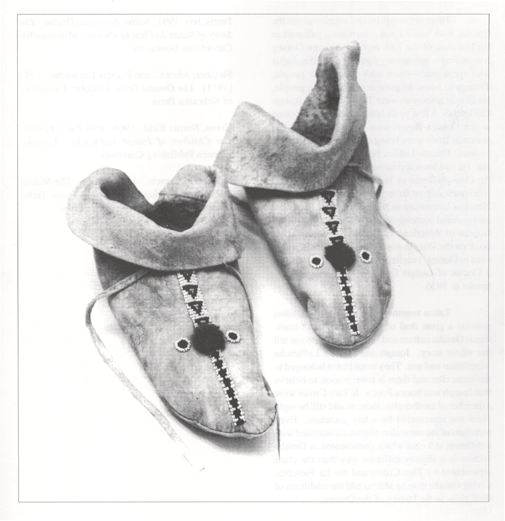
Fig 15.Beaded moccasins. Property of the Omaha Tribe.
BIBLIOGRAPHIC NOTE
There are two principal sources about the Omaha, both based upon information gathered in the last third of the 19th century. J.Owen Dorsey was at first a missionary and then an ethnologist who spent many years with the Omaha people. Though he learned a great deal from many people, his closest associates were Two Crows and Joseph LaFlesche. A few years later, Alice Fletcher came to the Omaha Reservation at the time that the common lands were being allocated to individual owners. Francis LaFlesche was her close associate. He had been appointed a clerk in the office of the Commissioner of Indian Affairs in 1881 and received a degree from the School of Law of the National University in 1893. LaFlesche became a professional anthropologist which he joined the Bureau of American Ethnology in 1910. Their book on the Omaha was completed without reference to Dorsey's earlier work. LaFlesche received a Doctor of Letters from the University of Nebraska in 1926.
Taken together, these two early studies provide a great deal of information about traditional Omaha culture and society. They do not tell the whole story. Joseph and Francis LaFlesche were father and son. They would have belonged to the same clan and there is some reason to believe that Joseph was born a Ponca. If Two Crows were a member of another clan, there would still be eight clans not represented by a key associate. Even members of the same clan might be associated with a different sub clan which participated in Omaha society in a slightly different way than the clans represented by Two Crows and the La Flesches. Living Omaha may be able to add the traditions of their clans to the history of the Omaha.
SUGGESTED READINGS
Ferris, Jeri. 1991. Native American Doctor: The Story of Susan LaFlesche Picotte. Minneapolis: Carolrhoda Books, Inc.
Fletcher, Alice C. and Francis LaFlesche. 1972 [1911]. The Omaha Tribe. Lincoln: University of Nebraska Press.
Green, Norma Kidd. 1969. Iron Eye's Family: The Children of Joseph LaFlesche. Lincoln: Johnsen Publishing Company.
LaFlesche, Francis. 1978 [1900]. The Middle Five: Indian Schoolboys of the Omaha Tribe. Lincoln: University of Nebraska Press.
| More Omaha Heritage E-texts |


